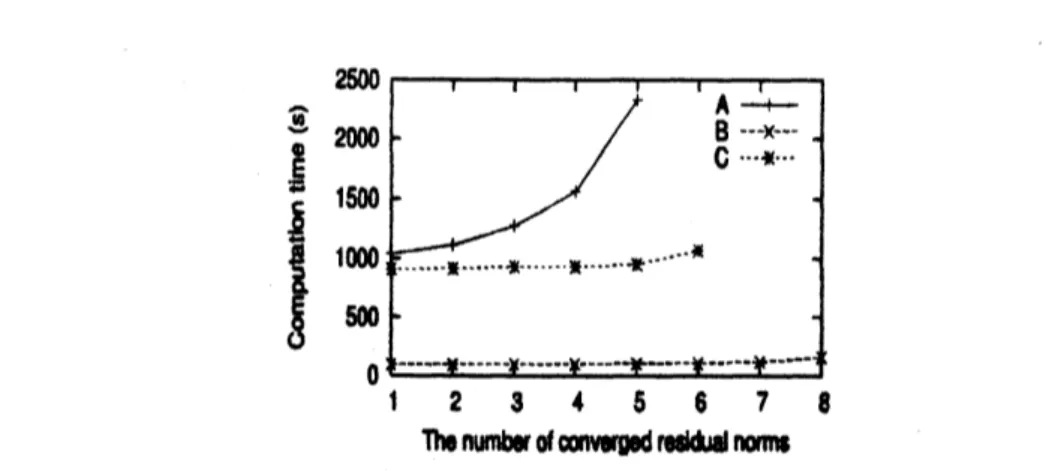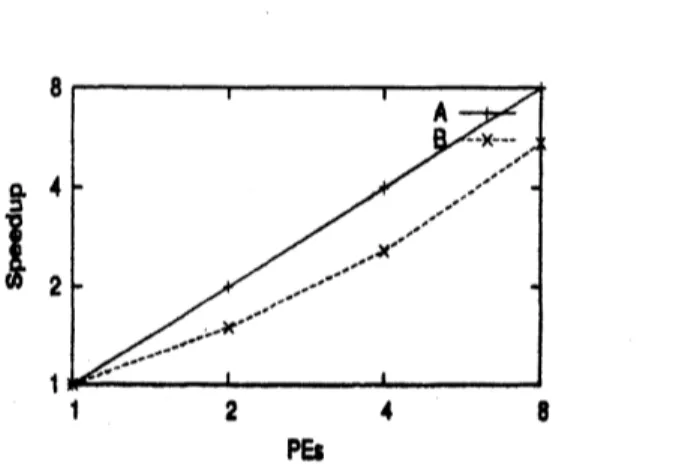The efficient
parallel
implementation
of the
approximate
inverse preconditioning for
the
shifted
linear
systems
-focus
on
the
Sherman-Morrison
formula-Kentaro Moriya, Aoyama GakuinUniversity
Linjie Zhang, Graduated Schoolof Keio University
Takashi Nodera, KeioUniversity
1
Introduction
We studythe fOllowing linearsystemsof equations:
$Ax$ $=$ $b$ (1)
$f_{\iota\dot{\#}}$ $=$ $b$
,
$A_{i}=(A+\xi_{i}I)$,
$i=1,2,$$\ldots,$ $N-1$
.
(2)where $A,\tilde{A}_{j}\in\sigma^{x}$“ be
nonsinakular
and nonhemitianmatrices, andlet $\xi_{i}\in \mathcal{O}$be such that tbeshifted matriees $\tilde{A}_{1}$ is
nonsinakular.
Namely, the linear system (1) isealled by eeed qstm. Thecoefficient matrieesof linear systems (1) and (2) have only differententries
on
theirmain$d_{\dot{\mathfrak{B}}}$onal.In this paper,
rn
proposea
new
teChersique that applies AISM (AppraximateInverse with tbeShuman-Morrison formula) method to these linear systems of equations. Using the prpoeed
techersique,
we
alsocomparethe$p\epsilon rfomance$af the preconditioned GMRES$(m)$ algorithmWith theShifld-GMRRS$(m)$ algorithm. Atlast, numerical experiments
are
given.2
$ShiRed-GMRES(m)$
algorithm
We define the following two Krylov subepaces
$K_{m}(A, r_{0})$ $=8pan\{r_{0}, Ar_{0}, ..., A^{m-1}r_{0}\}$ $\overline{K}_{m}(\overline{A}_{i},\dot{r}_{0})$ $=8pan\{\mathfrak{k}_{0},\tilde{\mathcal{A}}_{1}\tilde{r}_{0}, \ldots,\tilde{A}_{1}^{m-1}\tilde{r}_{0}\}$
.
If$r_{0}=h\overline{r}_{0}$
,
then $K_{m}(A, r_{0})_{\sim}=\dot{K}(\tilde{A}, \tilde{r}_{0})$ is\epsilon atinfid.[Proofl As for $(A)^{k}\mathfrak{k}_{0}\epsilon K_{m}(\tilde{A}_{i},\tilde{r}_{0})$
,
where $k=0,1,$$\ldots,$ $m-1$
$( \tilde{A}_{1})^{k}\tilde{r}_{0}=h(A+\xi_{i}l)^{k}r_{0}=\sum_{j-\triangleleft}^{l}h\{kC_{j}\xi_{i}^{(k-j)}\rangle(A)^{\dot{f}}r_{0}\in K_{m}(A, r_{0})$ $0$
Therefore, the appraximate solutions of all the shifted linear systems
can
be solved by usingonly
one
Krylov subspaoe. Hawever, if $m$use
the $prmnditioner$ of the coefficient matrix $A$,
$K(AM^{-1},r_{0})$ is not $\eta_{t}rMent$ to A$(\tilde{A}M^{-1}\tilde{r}_{O})$ and the equality betmeen two Krylov subepaces
is
no
more
satisfled. The disadvantage of this iterative solver is that it is not easy to apply tbepreeonditioner to theselinear systemsof equations.
3 Some Preconditioners
1: for $k=1$ to $n$do 2: eelect河 $m_{k}^{(0)}$ 3: for$j=0$ toIMAX do $4:5$ : $\tilde{r}^{\int_{k}^{(j)}}j$ ) $=\epsilon_{k}-\tilde{A}\tilde{m}^{\int_{k})}r=\epsilon_{k}-Am(j)$ $6:7$ $\tilde{\alpha}=t^{-\int_{k})}\alpha=(r\prime 0)\lambda^{\sim},_{k}b))/(\tilde{A}f^{\int_{k}^{O)}})A^{tj)}’)/(Ar,\tilde{A}_{k}Ar\tilde{r}^{\int_{)\}}^{0)}}$ $8:9$ $m=m+\alpha r\dot{m}^{\int_{k})}=\tilde{m}^{\int_{k})}+\tilde{\alpha}f^{\int_{k})}(j)C\dot{2})(j)$ 10: endfor 11: endfor Figuoe 1. MR $metk\sim$
3.1
MR Method
Thepreconditioner $M^{-1}i\epsilon$computed by the following
recurrences
$r_{k,(j)}^{(\dot{g})}$
$=$ $e_{k}-Am_{k}^{(j)}$
$m_{k}$ $=$ $m_{k}^{(j)}+\alpha r_{k}^{[j)}$
,
where $m_{k}^{[j)}$ is the k-th $\infty lumn$ vector of $M^{-1}$ in tbe j-th step ofMR iteration. Tbe oealar $\alpha$ is
daermin$6edd$
so
that the residualnorm
$||r_{k}^{[j)}||_{2}$ is minimized. It is usually set$u$
$\alpha=(r_{k}^{\{\dot{g})}, Ar_{\tilde{k}}^{t\dot{s})})’(Ar_{k}^{(j)}, Ar_{k}^{[\dot{g})})$
.
We preM the MR method in Figure 1. The notation “IMAX“
means
the iterations of MRmethod. Wlile the line number4,
6
and 8 preeentthe computationofpreconditionerofthelinearsystem (1), the line number 5,
7
and9
P 烈簡 em the $\infty mputation$ ofpreconditioner of the linearsystems (2). As the number ofthe shiftedlinear systems (2)
is
more
increased, the $\infty mputati\alpha 1$of thi8 preconditioner $bemR$
more
expenslve. Therefore, it is notso
aPpropriateto apply thispreconditionerto theshifled linearsystems.
3.2
AISM
method
Wedefine$p_{k}=e_{k}$ and$q_{k}=(a_{k}-se_{k})^{T}$, where$a_{k}$ and $e_{k}$
are
the $k\cdot th\infty lumn$ vecter of$A$,
and the identity vector, raepectively. Using the$f_{0}nowing$threerecurrenoe
fomula$u_{k}$ $=p_{k}- \sum_{i=1}^{k-1}\frac{(*)_{k}}{\epsilon r_{1}}*$
,
$v_{k}$ $=q_{k}- \sum_{1=1}^{k-1}\frac{(q_{k},*)}{\epsilon r_{i}}v_{i}$,
and
1: for $k=1$ to $n$do 2: $p_{k}=e_{k}$ 3: $q_{k}=a^{k}-\epsilon\epsilon_{k}$ 4: $u_{k}=p_{k}$ 5: $v_{k}=q_{k}$ 6: for $i=1$
to
$k-1$ do7:
$u_{k}=u_{k}-\{(v_{i})_{k}/(sr_{i})\}u_{i}$ 8: $v_{k}=v_{k}-\{(q_{k}, 4)/(sr_{i})\}v_{i}$ $9$: endfor 10: for $i=1$ to$n$ do 11: if$|(u_{k})_{i}|<tolU$ 嫁 et $(u_{k})_{i}=0$ $12$: if$|(v_{k})_{i}|<to1V$ 嫁et $(v_{k})_{i}=0$ $13$: endfor 14: $r_{k}=1+(v_{k})_{k}/\epsilon$15:
endhrFigure 2. Tbe AISM method
TheAISM$p\iota mndilion\alpha$isdescribed
ae
$fo1]_{oW8}$.
$M^{-1}=sI-A^{-1}=\epsilon^{-2}U\Omega^{-1}V^{T}$ ($)
$wh\alpha e$
$U=$ $\{u_{1}, u_{2}, \ldots,u_{\mathfrak{n}}\}$ ,
$V$ $=$ $\{v_{1}, v_{2}, \ldots,v_{\hslash}\}$
,
and
$\Omega=diag\{r_{1}, ra, ...,r_{n}\}$
.
In Figuie2,
we
preeenttbeAISM
method. The$\infty mputation$of$u_{k}$ and$v_{k},$ $(k=1,2, \ldots,n)$ in linenumber5and6
can
beprallehzedpartiallybasedon
Moriya etal. [5]. $Tbek_{R}$AISM
method isparallelizedin the numericalexample. Justlilcein MRmethod, the dropping offprocemis used in
thestatement of line number9and
10.
If the k.th entries of$u_{k}$and$v_{k}$re
a
than the throehol&tolU andtolV, respectively. About
more
detail of theAISM $pr\alpha nndition\alpha$,
see
Bru et a1.[4].4
The
technique
applying
AISM
method
to
the
shifted
linear
$syy$tems
While the preecmditioner of seed
wtem
(1) is given in tk equation (3), the preoonditioner ofAifldlinear systems (2) isdescribed
as
$\tilde{M}^{-1}$
$=$ $\epsilon^{-1}I-\tilde{A}^{-1}$
$=$ $(s^{-1}-\xi^{-1})I-A^{-1}$ $=$ $\tilde{s}^{-1}I-A^{-1}$
.
Therefore,if8and$\tilde{s}$
are
thesame
values, thesame
$pre\infty nditioner$canbe used forthe linear systems(1)and(2). We proposethetechniquethatapplies only
one common
preconditionerto all the linearsystems. In the proposed technique, we set $\epsilon=\tilde{\epsilon}$ and select the appropriate values for both of
preeonditionersoflinear systems (1) and (2).
$Ac\infty rding$ to Bru et al. [4], it is known that the preconditioner $M^{-1}$ performs well, when
$s>p(A)$ is$8ati\epsilon fid$insystm (1),where$\rho(A)$ isthe spectralradiusof$A$
.
Thenallthe eigenvaluesnear zero
pointcan
be moved totheleft sideofcomplex plain, and the$\infty nvergence$of the residualnorm
isimproved. Basedon
the theorem in Bru et al. [4], the conditions$s>\rho(A)$
,
$s>\rho(\tilde{A}_{i})$,
for$i=1,2$,
...,$N-1$ (4)are
satisfied, theAISMmethod isexpectedto$\infty mpute$an
effective$pr\infty ondition\alpha$for all theshiftedlinear systems. Oneof the appropriate$\epsilon kctionl$that achieve$\epsilon>\rho(A)$ is
$\epsilon=1.5||A||_{\infty}$
,
(6)andjust like the
same
reason, if$\epsilon=1.5||\tilde{A}_{i}||_{\infty}$
,
for $i=1,2,$$\ldots,$ $N-1$
.
(0)is set, $\epsilon>\rho(A)$ is alsoeatisfied. Homm, it is impossibleto satisfyboth $\infty nditim\epsilon(5)$ and (6).
Insted of thistwo $\infty ndition\epsilon$
,
me
propoeetbeselection of$\epsilon$so
that$s>1.5||A||_{\infty}$ (7)
rd
$\epsilon>1.5||\tilde{A}||_{\infty}$
,
景\pi$i=1,2,$$\ldots,$ $N-1$ (8)
are
satisfled. If$\infty nditions(7)$ and (8) $m$satiSfied, conditions (4)are
also$\epsilon at\dot{n}$fld. We select$\epsilon=1.5(||A||_{\infty}+\max_{1}|\xi_{i}|)$ (9)
$u$ tbeappropriatescholar$\epsilon$for all the shifled limusystems. If the quation (9) isselected, both
$\infty n\bm{i}tions(7)$ and (8)
are
satisfied.
$p_{ro}\eta$ $s$ $=$ $1.6(|| \mathcal{A}||_{\infty}+\max_{1}|\xi_{i}|)$ $>$ $1.5||\mathcal{A}||_{\infty}>\rho(A)$ $\epsilon nd$ $\epsilon$ $=$ $1.5(||A||_{\infty}+m_{1}x|\xi:|)$ $=$ $1.5(m_{i}||\mathcal{A}||_{\infty}+m_{i}\alpha|\xi_{i}|)$ $>$ $1.5m_{i}\alpha\{||A+\zeta_{i}I||_{\infty}\}$ $=$ 1.6$\max_{i}\{||A\cdot||_{\infty}\}>1.5\{\Vert A||_{\infty}\}\geq\rho(A)$ 口
Therefore, if tbe equation (9) $\dot{r}$ emplayed
as
the diagonalshiftnd value$s$
,
we oen
obtainone
5
Numerical results
In this section,
we
praeent resultsofthe two numerical experiments. Ourcomputationswere
donein thefollowing
PC
clustersystemwith8 CPUs.
cluster Node: IBM
Xseries346
$(x4)$CPU:
Pentium43.
$6GHz$ ($2$ perone
node)OS: Fedora Core 4 Linux
Local
memory:
IGB $p\alpha$one
nodeCommunication library: MPI[7]
Themainexperiments
are
measuring thespeedupratio oftheAISM$pr\epsilon\infty nditionoe$and$\infty mpa\bm{r}ing$the AISM preconditioned GMRES$(m)dg\alpha ithm$ With the
Shifl\’e-GMRBS(m)
algorithm. Thepreconditioning parameters
are as
$fol$]$ow8$.
MR method
$\bullet$ Dropping off tolerance: tol$=0.1,0.01$ $\bullet$ Iterations: IMAX $=1,2$
AI8M method
$\bullet$ Dropping offtolerance: tolU $=0.1,0.01$ $\circ$ Dropping offtolerance: tolV $=0.1,0.01$
$\bullet$ Diagonal shifted value: $\epsilon=1.5(||A||_{\infty}+nlK|\xi_{i}|)$
[Bxmmple 1] In tbe $\Re uare$region $\Omega=I^{0},1]^{2}$
,
we
now
$\infty n\epsilon ider$the boundary value problem ofPDE
$-[\{\alpha p(-xy)\}u_{x}]_{x}-[\{\alpha p(xy)\}u_{y}]_{y}+10.0(u_{x}+u_{y})- 0.b=f(x,y)$
$u(x, y)|_{\delta\Omega}=1+xy$
We discretize this problem by usingfivepoinnts differential scheme with
1922
grid points toobtain tbecoefficieot matrixof order 36,864. Westudytheeigenvalueproblemof tbecoefficient matriX based
on
tbe Figure3.
We choose theoentralpoint $c=(0.15,0)$ and theradius $R=0.14$.
The numberof shifted linew systems$N$ is 8. The right handside $b$ is determined
so
that all of its$ntri\alpha$re
1.0. Theshifted linearsystemsin line
3
of this figurearesolvedby the preconditimedGMRES$(m)$dgorithm and the $Shiftd\cdot GMRES(m)$ algorithmto$\infty mpue$theseiterativesolvere. We $8trt$tbe
iterations with the initial approocimation of
zero
vector. ‘Itible1presents the$\infty mputation$time anditeratians needed for satisfying thestoppingcriterion
$|\{r_{l}||_{2}/||b||_{2}<1.0x10^{-12}$ (10)
about $n$ the residualnorms, where $||r_{i}||_{2}$ is the i-th residual
nom
ofGMRES iterations. Tbevalue in brscket $u()$
means
the number of the raeidMnorms
thatcan
not $\infty nverge$ withinone
1: select $c,$ $R,$ $N,$ $m$andvectors$b,$ $d$
2: set 吻$=c+R\alpha p(*j),$ $j=0,1,$$\ldots,$$N-1$ 3: solve $(A-\omega_{j}I)ae_{j}=b,$ $j=0,1,$$\ldots$,$N-1$
4: $M$ $f($吻$)=d^{H_{l_{j}}},$ $j=0,1,$$\ldots,N-1$
5: compute $\beta_{j}=\pi^{1}\sum_{k=1}^{N-1}(w_{k}-e)^{j+1}f(w_{k}),$ $j=0,1,$
$\ldots,$$2m-1$ $6$: compute eigenvaiuee $\theta_{0},$
$\ldots,$ $\theta_{m}$of$ff_{m}-\lambda\overline{H}_{m}$ 7: compute $\lambda_{j}=\theta_{j}+c$
Figure 3. The algorithm to solve the eigenvalue problem with using tbe shifted linear$rnteI\infty$
‘Tlible 1. Example 1: Computation timeanditerations ofshifld $hnA$systems (time: computa.
tion time (s), iter: iterations)
$\infty nv\Re\Re$
.
Sme of theresidual normscan
not $\infty nver\Re$ incases
ofMR method and theShifted-GMRES
$(m)$ algorithm. The mnputation time of MR preconditioner is muchmore
expensivethan AISM $poeconditi\bm{m}\alpha$
,
and its cost is not practical. On the othoe hand, with uslng AISMpreeonditioner, the
iterations
are
termmated at mest threeminutes. Therefore,we
find that it iseffectiveto aPply
one common
preconditionerto all thelinearsystems.Figure 4 presents the number of the converged residual
norms
$u$ for the $\infty mputation$ time.In the AISM method, all ofthe $\varpi idM$
norms
$\infty nvaege$ aimost $sim\iota \bm{P}\tan\infty mly$.
Incase
of theShifld-GL4RES$(m)$ algorithm, the $\infty n\backslash \alpha genoe$ of the 5th residual
nom
i8 about 1,000 seeondsslower than the hst \infty nwrg\’e residual
nom.
Also, it takes about 1,000 Kon& for the flrstroeidd
mrm
to $\infty nv\alpha ae$.
In MR $p\iota mnditior$, six residualnorms
$\infty nv\alpha ge$ almost thesame
time. However, tbe run time cost is about 1,000 seconds to $\infty nverge$, and the last tvve residual
norms
donot $\infty n\bm{v}eoe$.
We
measure
the$pua\mathbb{I}el$perfiormanoe ofAISMmethod. In Figure5, uPto 4 PEs, tbe$\Phi^{\ovalbox{\tt\small REJECT} up}$ratio isalmoet linear, and it is decreased in the
case
ofusing8
PEs, andthesPeeduP
ratio isabout4.5 tin$loe$
.
Rmple $l$] We $\infty n\mathfrak{g}ider$ tbe matrix, $nmdu_{ECL32’}$ in the Florida Sparse $Matr\dot{\alpha}$ 欧化 lleo
tion [6]. The order and
non
$ger\infty$ofthematrixare
51,993, 347,007, respectively. Theright handside is determined
eo
that all theentriesare
1.0.
Just like in Example 1, the numberof shiftd$\mathfrak{n}rnu\dagger ud\varpi m u\alpha dmi\hslash\ovalbox{\tt\small REJECT}$
Figure 4. Example 1: The relation of the number of converged residual
norms
and$\infty mputation$ time ($A$: Shifted-GMRES(40), $B$: MR+GMRES(40), tol$=0.1$
,
IMAX$=1$,
$C$:AISM+GMRES(40), tolU, tolV$=0.1$)
Pb
Figure5. Example 1: Perfomanoeanslysisof
AISM
method, ($A$:idael, $B$: AISM method, tolU,tolV$=0.1$)
3. In $th\dot{n}\alpha ample$
,
the oeIAral point of$c=(1.0,0)$ and tbe radius of$R=0.99$are
selected.Thble 2presents the$\infty mputation$timeanditerations needed for stoppingcriterion(10). Aceording
to this table, AISM method enable all the residual
norms
to converge about fouror
five timesfaster than MR method. Also the preconditioningcostofAISMmethodisnot
so
expensive$u$ MRmethod. Even if the iteratlom ofMRmethod “IMAX“ is increased, the$\infty mputation$eost
can
notbereduoed, and rather$\alpha p\alpha 1$sive. The$c\infty t$ ofMR method ismore than 10 times
as
apansive $u$AISMmethod.
In the
Shifld-GMRES
$(m)a\Re rithm$,
onlythelast reaidualnormcan
notconvergo. TherdOre,we
analyze the relationbetween the $\infty nvoeffi$residualnorms
and$\infty mputation$time. Ftom Figure6, the $\epsilon hiRd- GMhS(m)$ algorithm enables
seven
residualnorms
to ecmverge much faster thantbe other $poe\infty ndition\ovalbox{\tt\small REJECT} GMR\bm{E}S(m)$ algorithm. However, the last
one can
not $\infty nver\Re$.
The$Shifled- G\mapsto ms(m)$ algorithm is expensive for not all the linear systems, and the $\ovalbox{\tt\small REJECT}$ is
rather quick thanAISM metkd. Only
one
roeiduAmrm
does not converge. Onthe otherhand,$\mathbb{R}ble2$
.
Example2: Computation time and iteratiom of shifted linearsystms (time: $\infty mputa$.
tiontime (s), iter: $it\alpha atiom$)
lhenumber of oonvorgedresidualnerms
Figure 6. Example 2: The relation of the momber of Convergxl $r\alpha idM$
norms
and$\infty mputation$ time ($A$
:
Shiftd-GMRES(20), $B$: MR+GMRES(20), tol$=01$,
IMAX$=1$,
$C$:AISM+GMRES(20), tolU, tolV$=0.1$)
Figure7shovva thespeedupratio ofAISM method. In this experinmot, the
wallel
performanoeis not
so
dffectiveas
Example1, sinoethe gparse structureof the matrixismore
irregular. Incase
of8 PEs, the speedup of about 4times isobtained.
6
Concluding
remarks
We have propoeed
a
new
technique ofAISM method for applying the shifted linear $\varphi tm$.
Inthe originalscheme, $eith\alpha$the Shifid-GMRES(m) algorithm without$pre\infty nditioning$
or
the pae$\cdot$eonditiCned
GMRES
$(m)$ algorithm with expensive$\infty mputation$ eoet, like MR method, is$\tau nu\triangleleft ly$used. On the other hand, the proposed technique
can
$\infty mpute$one common
$pr\infty ondition\alpha$of fflthe systems. itdoes net depend
on
the momber of linear$\epsilon yst\epsilon m$.
$Rom$two numerical rmples, itiseffective to apply theAISM$proeonditi\bm{m}\varpi$to tbeshiftedlinearsystmswithusing tbe propoeed
technique. We
can
alsoobtain the speedup ratioofabout 4 timesby $u\epsilon ing8$ P&. Therebre, thisPa
Figure 7. Example 2: Perfomanoe analysis of AISM method, ($A$
:
ideal, $B$: AISM, tolU,tolV$=0.1$)
In the future work,
we
plan to study the detailed mmerical perfOrmamce ofour
algorithm toallocating Aofshiftedsystms (2) toseed systm (1).
References
[1] GMRES: A Generalized Minilmal Residual Algorithm for Solving NonsymmetriC Lin$m$
Sys-tems, SIAM J Sci. Stat. Comput., No. 7, pp. 856-869 (1986).
[2] Ebommer, $A$, and Glassner,U.: naetarted GMRES $f\alpha$ Shifbed LinearSystems, SIAM J. Sci.
Comput., Vol. 19, pp. $1\succ 26$ (1998).
[3] Hudkel. T.: Appmimate Sparsity Patterns for the Inverse of
a
Matrix and Preeonditioning,Appl. Numer. Math., No. 30, pp. $291-W\theta$ (1999).
[4] Bru, R., Crddn, J., and Marfn, J., Mas, J.: $Pr\infty Mition\dot{m}g$Spaise $Non\eta mmetric$ Lmm
systems with the $ShermaI\triangleright Morri8on$ Ebmula, $suM$ J.
Sci.
Comput., Vol. 25, No. 2, pp.701-715
(2003).[5] K. Moriya, L. Zhang, and T. Nodera: Tbe computation of the appmimate in$m$by
par-$a\mathbb{I}e\ ing$ tbe Sherman-Morrison fomula (in Japanese), J.
of
IPSJ, Vol. 48, No. 3 (2007) to$appe\alpha$
.
[6] Unirsity of Florida Sparse Matrix Collection. [Online] http:$//www.ci\Re.\bm{t}.du/r/\epsilon p\sim$
$I^{I}ae/matri\infty$
![Figure 2. Tbe AISM method The AISM $p\iota mndilion\alpha$ is described ae $fo1]_{oW8}$ .](https://thumb-ap.123doks.com/thumbv2/123deta/5995966.1061555/3.892.96.816.129.757/figure-tbe-aism-method-aism-mndilion-alpha-described.webp)



